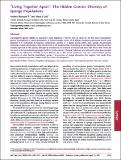Por favor, use este identificador para citar o enlazar a este item:
http://hdl.handle.net/10261/46231COMPARTIR / EXPORTAR:
 SHARE SHARE
 CORE
BASE CORE
BASE
|
|
| Visualizar otros formatos: MARC | Dublin Core | RDF | ORE | MODS | METS | DIDL | DATACITE | |

| Campo DC | Valor | Lengua/Idioma |
|---|---|---|
| dc.contributor.author | Blanquer, Andrea | - |
| dc.contributor.author | Uriz, María Jesús | - |
| dc.date.accessioned | 2012-02-24T13:50:39Z | - |
| dc.date.available | 2012-02-24T13:50:39Z | - |
| dc.date.issued | 2011 | - |
| dc.identifier.citation | Molecular Biology and Evolution 28(9) : 2435-2438 (2011) | es_ES |
| dc.identifier.issn | 0737-4038 | - |
| dc.identifier.uri | http://hdl.handle.net/10261/46231 | - |
| dc.description | 4 páginas, 3 figuras. | es_ES |
| dc.description.abstract | Intraorganism genetic stability is assumed in most organisms. However, here we show for the first time intraorganism genetic heterogeneity in natural populations of marine sponges. A total of 36 different multilocus genotypes (MLGs) were detected in 13 individuals of Scopalina lophyropoda sampled at 4 distant points within each sponge. All genotypes (showing a mosaic distribution), were transmitted to the progeny, thus contributing to the high genetic diversity and low clonality reported for this species, although its populations are small and structured and show high fission rates. There did not seem to be intraindividual genotype conflicts; on the contrary, chimeric individuals are expected to show low mortality thanks to the differential mortality of their different MLGs. This novel mechanism may also counterbalance genetic constraints in other benthic invertebrate species. The presence of sponge chimerism also suggests that results from previous population genetics studies could have been misinterpreted. | es_ES |
| dc.description.sponsorship | This work was supported by the Spanish Government (CICYT) (BENTHOMICS CTM2010-22218) to M.J.U. | es_ES |
| dc.language.iso | eng | es_ES |
| dc.publisher | Oxford University Press | es_ES |
| dc.rights | openAccess | es_ES |
| dc.subject | Intraorganism genetic heterogeneity | es_ES |
| dc.subject | Mosaics | es_ES |
| dc.subject | Porifera | es_ES |
| dc.subject | Chimeras | es_ES |
| dc.subject | Scopalina lophyropoda | es_ES |
| dc.subject | Genetic diversity | es_ES |
| dc.title | Living together apart. The hidden genetic diversity of sponge populations. | es_ES |
| dc.type | artículo | es_ES |
| dc.identifier.doi | 10.1093/molbev/msr096 | - |
| dc.description.peerreviewed | Peer reviewed | es_ES |
| dc.relation.publisherversion | http://dx.doi.org/10.1093/molbev/msr096 | es_ES |
| dc.identifier.e-issn | 1537-1719 | - |
| dc.type.coar | http://purl.org/coar/resource_type/c_6501 | es_ES |
| item.openairetype | artículo | - |
| item.grantfulltext | open | - |
| item.cerifentitytype | Publications | - |
| item.openairecristype | http://purl.org/coar/resource_type/c_18cf | - |
| item.fulltext | With Fulltext | - |
| item.languageiso639-1 | en | - |
| Aparece en las colecciones: | (CEAB) Artículos | |
Ficheros en este ítem:
| Fichero | Descripción | Tamaño | Formato | |
|---|---|---|---|---|
| living together.pdf | 326,99 kB | Adobe PDF |  Visualizar/Abrir |
CORE Recommender
SCOPUSTM
Citations
21
checked on 10-abr-2024
WEB OF SCIENCETM
Citations
19
checked on 23-feb-2024
Page view(s)
342
checked on 22-abr-2024
Download(s)
212
checked on 22-abr-2024
Google ScholarTM
Check
Altmetric
Altmetric
NOTA: Los ítems de Digital.CSIC están protegidos por copyright, con todos los derechos reservados, a menos que se indique lo contrario.
